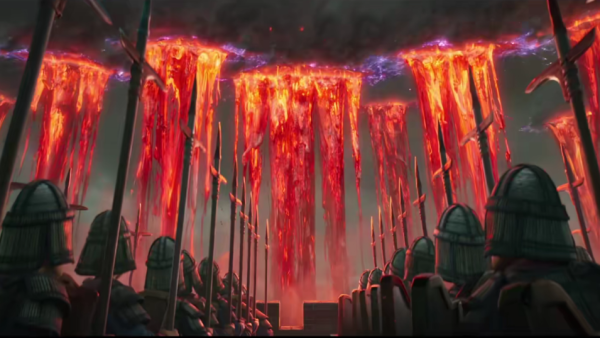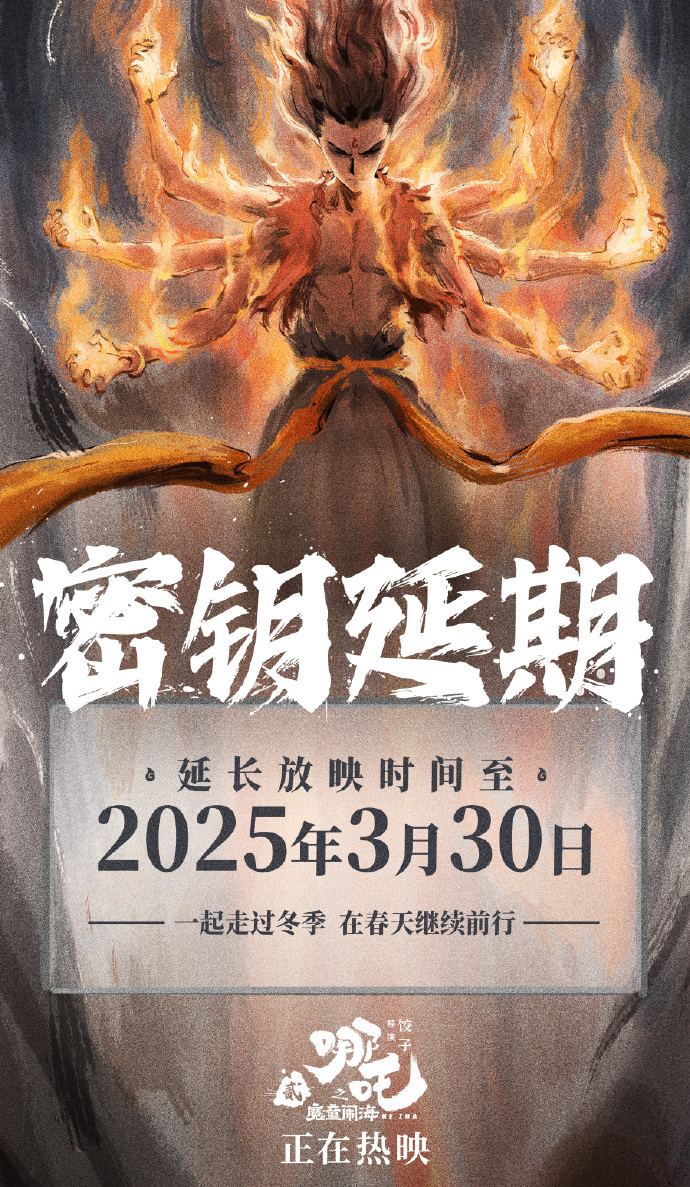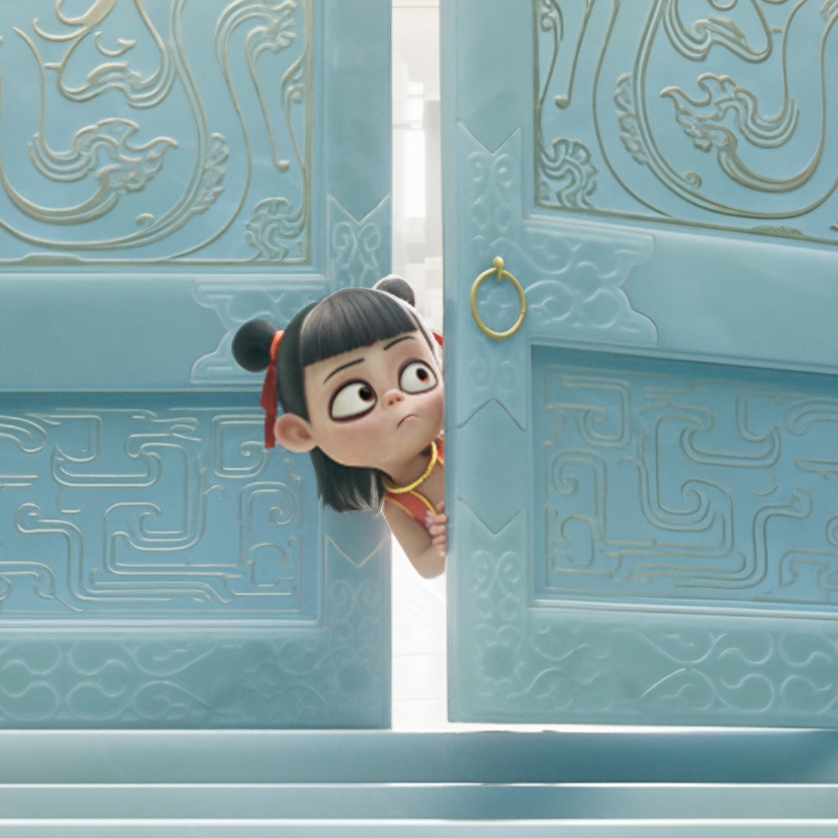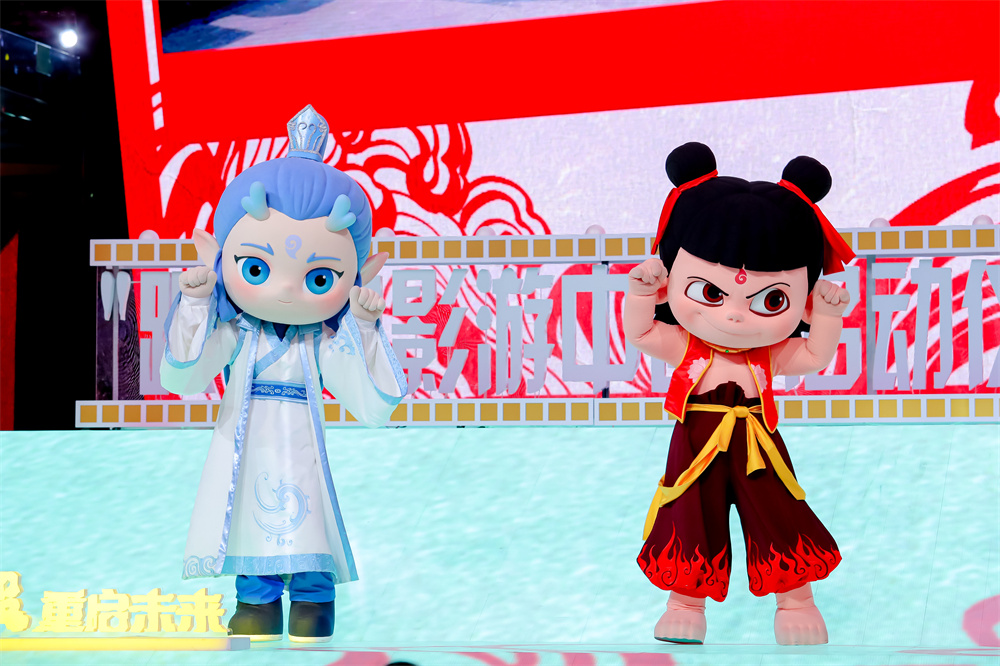


"Nezha: The Devil Boy Conquers the Dragon King" has exceeded 700 million posters
Five years ago, a little boy with smoky makeup appeared out of nowhere, creating a highlight moment for Chinese animated films with a box office of over 5 billion and excellent reputation. In the five years since then, it has become the "ceiling" of Chinese animated films, leaving behind the latecomers by a large margin.
Five years later, the magic pill and the spirit pearl have returned in flesh and blood, re-interpreting the well-known story of the sea battle. The moving plot that makes people excited and tearful, coupled with the audio-visual experience brought by the blood-pumping and breathtaking spectacles, is more exciting, more refreshing and more imaginative. "Nezha 2" once again proves that it is the well-deserved "return of the king" of Chinese animation.

The day after its release, the film received a high score of 8.5 on Douban
From the data dimension, the upgrade of "Nezha: The Devil Boy Conquers the Dragon King" is very significant. The number of characters is three times that of the previous work, and there are more than 1,900 special effects shots, which alone exceed the total number of shots in the entire film "Nezha: The Devil Boy Comes into the World" (1,800+). The entire story volume has been comprehensively upgraded, and the worldview of the immortal world, the human world, and the demon world has been further expanded, presenting a more grand and rich world of Fengshen for the audience.
Like the previous one, the production of the second part also took five years. During these five years, the technology and the industry environment have undergone tremendous changes, and the creators have worked hard in the midst of it, bringing the production level of Chinese animation to a new height. The production of some shots even runs through the entire production cycle.

Poster of Nezha: The Devil Boy Conquers the Dragon King
"We need to show something that has not been seen in previous movies, and have fresh strengths in terms of concepts, gameplay, and visual effects. If it is not fresh, it will definitely be passed." Director Jiaozi spared no effort in the pursuit of perfection, and "leaving no way out for yourself" became the slogan of the entire team. "We have done so well in the beginning, so we have to break through and do better in the end. This is a process of forcing ourselves." Jiaozi described this creation.
If we say that when making "Nezha: The Devil Child Comes into the World", the team was faced with the dual pressure of completing the established goals and maintaining survival, and had to divide their energy to focus on matters other than creation, when it came to making "Nezha 2", whether it was Jiaozi's ability to become more focused and pure in the creation, or the mutual promotion brought about by the participation of elite talents from the entire industry, a strong atmosphere of "must make the work the best" was formed.
Liu Wenzhang, president and producer of Coco Bean Animation, co-founded "Jiao Keli Animation Studio" with Jiaozi in 2009 and is a witness to the growth of "Nezha" with Jiaozi. Leading a team and project that "leaves no way out for itself" is a blessing for the audience, but for the producer, the pressure is imaginable.
When Liu Wenjian talked about the creative process of "Nezha 2: The Devil Boy Conquers the Dragon King", it seemed long and normal. Solving problems one by one day after day, the work naturally grew into its own shape.
In the previous film, the animation companies involved in "Nezha: The Devil Child Comes into the World" were scattered across the country, with a production team of more than 1,600 people from more than 60 companies, allowing Nezha to wear the industry's "Ten Thousand Scale Armor". This time, the staff involved in the animation exceeded 4,000. It is precisely because of the confidence brought to the entire industry by the previous success that more high-quality talents and resources have come to Chengdu for persistence and passion, turning the project into an "Olympic Village". Therefore, those "things that we dared not think of five years ago" have reached new heights this time, standing on tiptoe together.
Before the film was released, producer Liu Wen Zhang accepted an exclusive interview with a reporter from The Paper, telling the story of leading the athletes in an "Olympic Village" to sprint to the final sprint.

Producer Liu Wenzhang
【dialogue】
From breaking "fate" to breaking "rules"
The Paper: At what stage did you start planning for the second part? What considerations did you take into account when exploring the characters and the core of the story for the second part?
Liu Wenzhang: When we started the first film project, we had a series of plans, but we didn’t start the actual production until after Nezha 1 was released. At that stage, we reviewed the production, and we started the second film after the film was released in 2019. The second film had many new goals, and after the changes in the scale and difficulty, the production had to solve many new problems.
The characters in the second movie are basically set up as a continuation of the first movie. The second movie focuses on designing our dragon clan. This involves the form of the dragon itself and the form of the dragon turning into a human. There will be some connections between them, and we try to refer to some Chinese people's imagination of the Chinese dragon. At the same time, in order to combine with the plot of the martial arts, the four dragon kings must be differentiated. For example, Ao Guang is related to the water and ice system, so we have to design a majestic water knife and water dragon. Ao Qin, the Dragon King of the South China Sea, is related to the fire system and has a hot temper, so we set him a more arrogant martial arts style.

The Four Dragon Kings
In terms of theme, the last part was about breaking fate, and this time it is about breaking rules, which is a certain continuity. Because he will encounter different things, see some deception or injustice, which will affect his growth. I believe that people with social experience can better understand these experiences.
The Paper: Both the first and second series took five years to make. In your opinion, what are the differences between these two five-year periods?
Liu Wen: I don’t think there is any big difference. Creation is a very slow process, which requires patience and meticulousness to solve various problems. Looking back, I feel that it is actually very short, because I am always busy and my sense of time is vague. Including my colleagues, when we talk about this topic, we all sigh that it is long and short.
Mentally, the first film was probably to prove something, to show the audience that domestic animated films can be very different, and I was determined to do it. Although we had many limitations in terms of technical conditions and strength at that time, we did achieve the best possible state under the conditions and status we had at that time.
Of course, the technical strength of the second part is much better than the previous ones, but the goals of the second part and the quality we want to achieve have also been improved simultaneously, which has offset the advantages brought by the new changes. It is still a new challenge and faces a lot of problems, so the problems faced by the two parts are similar.

Stills from Nezha: The Devil Boy Conquers the Dragon King
The Paper: As Jiaozi’s partner for many years, in your observation, what obsessions or characteristics of Jiaozi determine the success of this work?
Liu Wen Zhang: When we were working on Nezha 1, in addition to achieving the set goal, we also had to consider the survival of the entire team. So the director may have to care about and pay attention to some things other than creation, that is, some practical problems of livelihood.
In the second part, I think he is more focused on the creation itself, and becomes more pure, which is the state a creator should have. I also think this is more suitable for him to pursue his creative goals. It is also because of his own state that he affects other teammates at the same time, so as mentioned earlier, a healthy competition and cooperation relationship is formed.
The Paper: When you work with more "pure" directors, do you ever have disagreements? Are there any examples where you initially thought he was "unrealistic" but ended up feeling proud of the results?
Liu Wenzhang: There was no so-called fierce confrontation, because the director had a clear plan in the early stage of creation, and he had participated in the whole process of production before, and had a good understanding of each link. He tried his best to consider the characteristics of production at the beginning of creation. In my opinion, he is also half a producer. From the execution level, the production department is to realize the director's ideas.
Of course, we did discuss some scenes, such as the chains that appeared in the battle of Chentangguan. Because thousands of sea monsters had to wear chains to fight and do all the movements, it was really like dancing in shackles. It was very difficult to produce, almost "impossible". You can imagine that tens of thousands of chains cannot be "exposed" in the fight between monsters, and at the same time, these chains are presented differently in the near, medium and long shots. When floating in the air, they must be like hair strands and have a certain gravity. When monsters and soldiers fight in close combat, the chains must also be beautiful in the fight.

Stills from Nezha: The Devil Boy Conquers the Dragon King
Initially, we discussed with the director whether we could set it as a "magic chain". For example, if it can be presented in certain situations but not in battle, it would save us trouble in production. But the director insisted on presenting it realistically, because from the perspective of the movie plot, it also confirmed such a "rule", that is, the bondage of the chain, which is also closely related to our theme. So we had to bite the bullet and continue to work on it. It really took a long time to finally solve such a technical problem.
Don't leave yourself a way out, the upper limit is "there is no best, only better"
The Paper: The production of "Ne Zha" was already top-notch in the entire animation industry. Where is the room for improvement to reach higher standards?
Liu Wenzhang: First of all, in terms of quantity, the change in volume is very large. The number of characters in Nezha 2 is three times that of Nezha 1, and the special effects shots alone exceed the number of shots in the entire film of the previous one. Nezha 1 has more than 1,800 shots, while Nezha 2 has more than 2,400 shots, of which more than 1,900 are special effects shots.
At the same time, our worldview has been further expanded. There are more than 300 characters in the film, and these characters are all newly polished, rather than reusing assets from the first film.
Another example is the upgrade of our scenes. In "Nezha: The Devil Child Comes into the World", most of the scenes were relatively small, showing our plot in relatively limited scenes. In this film, there are many very large scenes to present a more grand visual spectacle.
The Paper: After the production scale was significantly upgraded, what changes have taken place in the company, external environment, personnel status, working mode, etc.?
Liu Wen: The most important thing is the production cycle. When we produce in this way in all links, it will change a lot. Because each link hopes to achieve the best or extreme state in its own link, but our entire production is a linear process, which means that you must complete the early storyboard before you can do the subsequent development. It is a bit like handing over the baton. Only when the baton reaches a certain link can the subsequent work continue.
Therefore, each link watched the colleagues in the previous part to achieve the ultimate results, and no one wanted to become the "short board" of our entire barrel. As a result, a healthy competition and cooperation relationship was reached among the links, and everyone wanted their own link to better present the best results.
One problem with this is that it is a bit "competitive". Our upper limit is "there is no best, only better".

Stills from Nezha: The Devil Boy Conquers the Dragon King
The Paper: I heard that one of the team’s slogans is “Leave no room for retreat.” Where does this background come from? Is it a lot of pressure for a producer to lead a team that leaves no room for retreat?
Liu Wen: Yes, we do have such a saying internally, and we have always followed this spirit. We also said this when we made our first film, that we should treat every work as if it were our last. The reason we say this is because we believe that as long as you devote yourself wholeheartedly and work hard to achieve results, the audience will eventually see and feel all your efforts.
Of course, from the perspective of production, it is definitely a struggle. On the one hand, I am looking forward to it and encourage everyone to pursue perfection and the best results, but at the same time we are constrained by the cycle and cost. Sometimes I don't have the heart to dampen everyone's enthusiasm, but I know in my heart that it is more important to push the project forward, and this process is quite difficult.
As we often say, it is easy to improve from 60 points to 90 points, but if you increase your score by one point or even a few tenths of a point, you will spend several times or even dozens of times more time, and the input-output ratio is very low. This is also a difficulty in advancing our entire project. You must find a balance, so you need to stop at certain points in time.
Animation talents from all over the country have come to Chengdu
The Paper: Last time, when talking about the difficulties in the production process, Jiaozi mentioned that it was particularly difficult to coordinate with different companies across the country and that there were no unified standards in many links. Has the situation changed this time?
Liu Wen: I think there are indeed some changes, because when we were working on Nezha 1, our team was not well-known and the resources we could work with were limited. This time, we have basically cooperated with most of the teams we wanted to work with, and they are very willing to help us and support us very much.
We have a new cooperation model this time called "on-site". On-site means that the other party's team sends people to our company to stay for a period of time. In the past, most of the outsourced cooperation was remote. I am really grateful for the efforts of the on-site partners. Many of them left their homes to work in Chengdu, and they may stay for one or two years.

Stills from Nezha: The Devil Boy Conquers the Dragon King
The Paper: I interviewed an outsourcing company that participated in the production of Nezha before, and they said that Nezha at the time felt like "the hope of the whole village." As a practitioner, what positive impact do you think the success of Nezha has brought to the industry?
Liu Wen: Indeed, I am willing to accept this statement. The animation industry has always been in a difficult state. Even with so many new employees this time, there is still a shortage of staff. We also hope that through this work, more people will pay attention to this industry. We hope that after gaining more recognition through our work, we can attract more practitioners to join and inject more fresh blood into our industry. I think all the teams that join in the cooperation also hope to change this industry.
The Paper: The first Nezha has been at the ceiling of animation box office for five years. It is hard for subsequent animations to reach that position. Do you think this ceiling can be broken? Does the previous performance bring pressure?
Liu Wen: Because it has always received a lot of attention, everyone was very nervous during the process. We still hope that the audience will recognize our work again. We are afraid that the audience will be disappointed, so we will be very cautious in the production of each shot. Of course, we have expectations for the results. But as creators, we are not so sensitive to data. We just hope that the general direction will be good enough for experts to nod and the audience to applaud.


